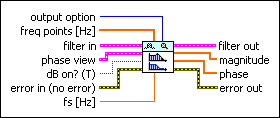DFD Get Freq Response VI
Owning Palette: Filter Analysis VIs
Installed With: Digital Filter Design Toolkit
Calculates the frequency responses, including the magnitude and phase responses, of a filter at specified frequency points.

 Place on the block diagram Place on the block diagram |  Find on the Functions palette Find on the Functions palette |
 | output option specifies the frequency response that this VI plots.
| ||||||
 | freq points specifies the frequency points, in hertz, at which you want to calculate the frequency response. | ||||||
 | filter in specifies the input filter. | ||||||
 | phase view specifies the phase response display settings.
| ||||||
 | dB on? specifies whether this VI uses decibels or a linear scale to express the magnitude response. The default is TRUE, which specifies that this VI converts linear magnitude response to decibels. | ||||||
 | error in describes error conditions that occur before this VI or function runs.
The default is no error. If an error occurred before this VI or function runs, the VI or function passes the error in value to error out. This VI or function runs normally only if no error occurred before this VI or function runs. If an error occurs while this VI or function runs, it runs normally and sets its own error status in error out. Use the Simple Error Handler or General Error Handler VIs to display the description of the error code. Use error in and error out to check errors and to specify execution order by wiring error out from one node to error in of the next node.
| ||||||
 | fs specifies the sampling frequency in hertz. The default is –1, which specifies that this VI uses the sampling frequency of the input filter. | ||||||
 | filter out returns the filter in unchanged. | ||||||
 | magnitude returns the resulting magnitude response at freq points. | ||||||
 | phase returns the resulting phase response at freq points. | ||||||
 | error out contains error information. If error in indicates that an error occurred before this VI or function ran, error out contains the same error information. Otherwise, it describes the error status that this VI or function produces.
Right-click the error out front panel indicator and select Explain Error from the shortcut menu for more information about the error.
|
Examples
Refer to the following VIs for examples of using the DFD Get Freq Response VI:
- Lpth Norm Complex Approximation-Compensate Channel Distortion VI: labview\examples\Digital Filter Design\Floating-Point Filters\Conventional
- Analyze Frequency Response of Filter with Log Spaced Freq Bins VI: labview\examples\Digital Filter Design\Getting Started\Analyze Filters




